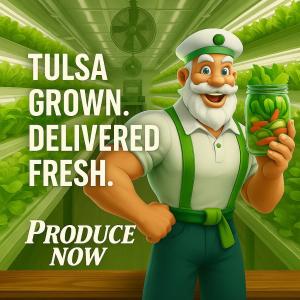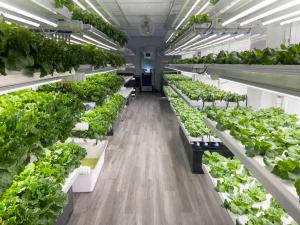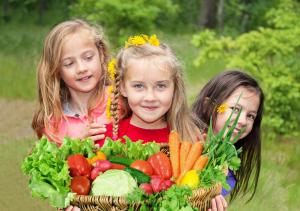Produce Now and Clean Food Initiative Launch Statewide Program to Bring Clean, Pesticide-Free Food to Oklahoma Schools
Growing Healthier Kids, Stronger Communities, and a Better Tomorrow.
Together, the organizations aim to address an urgent problem: over 90% of Oklahoma’s fruits and vegetables are imported, often arriving days or weeks after harvest and carrying harmful pesticide residues. According to a Consumer Reports 2025 special report, leafy greens like romaine lettuce were among the top 10 riskiest foods on store shelves today, citing contamination, unsafe farming practices, and long-distance transport as primary causes.
A recent article in The Atlantic adds further weight to these concerns. Experts quoted in the report—including Dr. James E. Rogers, Director of Food Safety Research at Consumer Reports—warn that “bagged salads are among the most problematic produce items in the U.S. food system,” due to bacterial outbreaks and systemic flaws in large-scale agriculture. The article highlights how leafy greens grown for mass distribution are particularly vulnerable to E. coli and Listeria contamination—problems that modular, hyper-local growing can help solve.
Produce Now utilizes GrowPods—modular indoor farms using filtered water and organic nutrients—to provide a clean, safe, and scalable alternative. These soil-free systems eliminate the need for pesticides or herbicides, and their controlled environments allow year-round farming with consistent quality and traceability.
“Oklahomans deserve access to food that’s not only fresh, but safe, traceable, and locally grown,” said Bree Boggio, co-founder of Produce Now. “This partnership is about giving consumers the power to choose better, and giving our youth the knowledge to lead that change.”
As part of the initiative, GrowPods will be placed at or near local schools and community centers where they will serve dual purposes: growing clean, nutrient-dense produce for lunch programs, and educating students about sustainable farming, food safety, and nutrition. By involving students in every step of the process—from planting seeds to harvesting meals—this program empowers them to make better food choices and lays the foundation for long-term health and food literacy.
“We’re not just growing food,” added Shannon Illingworth, founder of the Clean Food Initiative. “We’re growing awareness, responsibility, and healthier futures — one student, one harvest, one meal at a time.”
The partnership has three core objectives:
1. Deliver Clean, Fresh Produce to Schools – Using GrowPods to supply pesticide-free, locally grown greens and vegetables to school cafeterias and youth centers across Oklahoma.
2. Educate the Next Generation – Offering hands-on training in agriculture, nutrition, and sustainability to empower students and fight childhood obesity.
3. Raise General Public Awareness – Highlighting the public health risks of industrial farming and promoting Oklahoma-grown alternatives.
To make this vision a reality, the organizations are seeking support from Oklahoma companies, philanthropic organizations, family trusts, local investors, and all who care about children’s health and food security. The goal is to raise $100,000 to deploy initial GrowPods and launch accompanying educational programs.
“Together, we have the power to rewrite the story of food in Oklahoma — to replace chemicals with care, long-haul trucks with local hands, and helplessness with hope. With every dollar donated, you’re not just funding a garden — you’re planting seeds of resilience, of dignity, of a healthier generation.” Illingworth added. “Let’s grow more than produce. Let’s grow promise. Let’s grow pride. Let’s grow a future where every child knows what clean food tastes like — and knows they helped grow it.”
Join us. Support the movement. And help bring the roots of real change to our schools, our tables, and our children’s hearts.
To donate, volunteer, or learn more, visit www.producenow.farm
The future is growing — be part of it.
Shannon Illingworth
Produce Now
+1 405-441-0643
email us here
Visit us on social media:
Instagram
Facebook
Legal Disclaimer:
EIN Presswire provides this news content "as is" without warranty of any kind. We do not accept any responsibility or liability for the accuracy, content, images, videos, licenses, completeness, legality, or reliability of the information contained in this article. If you have any complaints or copyright issues related to this article, kindly contact the author above.
Synthetic Biology Market to Hit USD 84.7 Billion by 2035, Fueled by Advances in Gene Editing and Bio-Manufacturing
Zealmax Ortho at Pharmatech & Health, East Africa 2025, August 21-23, 2025
Metro East’s ISA Certified Arborists Offer 24/7 Emergency Tree Services to Protect Homes and Businesses
Więcej ważnych informacji
 Jedynka Newserii
Jedynka Newserii

 Jedynka Newserii
Jedynka Newserii

Farmacja

Nowy pakiet farmaceutyczny ma wyrównać szanse pacjentów w całej Unii. W Polsce na niektóre leki czeka się ponad dwa lata dłużej niż w Niemczech
Jeszcze pod przewodnictwem Polski Rada UE uzgodniła stanowisko w sprawie pakietu farmaceutycznego – największej reformy prawa lekowego od 20 lat. Ma on skrócić różnice w dostępie do terapii między krajami członkowskimi, które dziś sięgają nawet dwóch–trzech lat. W Unii Europejskiej wciąż brakuje terapii na ponad 6 tys. chorób rzadkich, a niedobory obejmują również leki ratujące życie. Nowe przepisy mają zapewnić szybszy dostęp do leków, wzmocnić konkurencyjność branży oraz zabezpieczyć dostawy.
Handel
Wzrost wydobycia ropy naftowej nie wpłynie na spadek cen surowca. Kierowcy jesienią zapłacą więcej za olej napędowy

Sierpień jest trzecim z rzędu miesiącem, gdy osiem krajów OPEC+ zwiększa podaż ropy naftowej na globalnym rynku; we wrześniu nastąpi kolejna zwyżka. Kraje OPEC, zwłaszcza Arabia Saudyjska, chcą w ten sposób odzyskać udziały w rynku utracone na skutek zmniejszenia wydobycia od 2022 roku, głównie na rzecz amerykańskich producentów. Nie należy się jednak spodziewać spadku cen ropy, gdyż popyt powinien być wysoki, a pod znakiem zapytania stoi dostępność ropy z Rosji. Nie zmienia to faktu, że jesienią ceny paliw na stacjach zazwyczaj rosną, a w największym stopniu podwyżki dotyczyć będą diesla.
Nauka
Szacowanie rzeczywistej liczby użytkowników miast dużym wyzwaniem. Statystycy wykorzystują dane z nowoczesnych źródeł

Różnica między liczbą rezydentów a rzeczywistą liczbą osób codziennie przebywających w Warszawie może sięgać nawet niemal pół miliona. Rozbieżności są dostrzegalne przede wszystkim w dużych miastach i ich obszarach funkcjonalnych. Precyzyjne dane populacyjne są tymczasem niezbędne w kształtowaniu usług społecznych i zdrowotnych, edukacyjnych, opiekuńczych, a także w planowaniu inwestycji infrastrukturalnych. W statystyce coraz częściej dane z oficjalnych źródeł, takich jak Zakład Ubezpieczeń Społecznych, są uzupełniane o te pochodzące od operatorów sieci komórkowych czy kart płatniczych.
Partner serwisu
Szkolenia

Akademia Newserii
Akademia Newserii to projekt, w ramach którego najlepsi polscy dziennikarze biznesowi, giełdowi oraz lifestylowi, a także szkoleniowcy z wieloletnim doświadczeniem dzielą się swoją wiedzą nt. pracy z mediami.











.gif)

 |
| |
| |
|